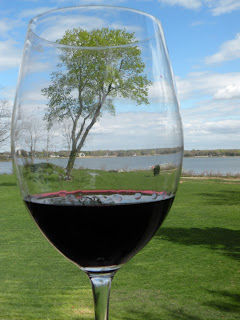I’m one of those people who can’t drink the white Zinfandel - I just can’t do it. What concerns me is how many people think that a mass-produced white Zinfandel is a good example of a Rose, without trying so many other pink wines that are available. For me, a Rose is an enjoyable, almost jovial wine that’s not intended to bridge the gap between reds and whites, but rather to have its own lovely identity. I’d like to share a few Rose wines from different regions that I’ve tried, that I believe are good yet inexpensive examples of what I feel make a Rose so enjoyable.
A really smooth, warm-weather Rose from right here on Long Island is the Waters Crest Rose, made of Merlot after just a few hours of contact with the grape skin. I tried this wine very recently without any food but I would be very happy to drink it again, preferably soon while the weather is warm, and pair it with fresh shellfish. The wine is a light salmon-pink, with characteristics of strawberry, candied citrus fruit, white blossoms, a bit of green and cool earthiness, and even something slightly exotic. Very fresh, light, and clean, with bright acidity and nice balance, and a very respectable finish, I couldn’t help but smile at just how enjoyable this wine is, and how I look forward to having it again.
 |
| 2009 Waters Crest Rose |
One of the biggest surprises I’ve experienced with a Rose was the Tasca d’Almerita Regaleali Rose, from the hills of central Sicily. Most people think of Etna Rosso blends and rustic Nero d’Avola when they conjure up thoughts of Sicilian wine. And after enjoying my share of reds and whites from Colosi and Corvo, the Tasca d’Almerita was something fun to try, after my parents brought back a bottle from a vacation to Rhode Island. The wine is made of Nerello Mascalese, a very important red grape in Sicily with substance and character. A bright, slightly bronzed salmon color, the wine has notes of bright red fruits such as strawberry, raspberry, and cherry, with just a hint of smokiness, indicative of the volcanic soil in which the grapes are grown. The texture is soft, the acidity and the tannins are very nicely balanced, and the finish is long, leaving the palate feeling very clean. I paired this wine with spaghetti and clams in a light sauce with herbs, and I feel this wine would go nicely with most shellfish, as well as lighter dishes of fish, poultry, and even some mild cheeses, and with pasta in a light tomato-based sauce.
One of the first Rose wines I came to enjoy was the Muga Rioja Rose during a harvest-themed party at our house in early autumn a few years back, where the main course was pork. Normally I prefer Riesling or Chardonnay with pork, but in the spirit of trying new things, I suggested this Spanish Rose, and the pairing was fantastic. A true light pink Rose, this Spanish wine from Rioja is made of Garnacha, Viura, and Tempranillo, and displays characteristics of almost-ripe strawberry and fresh herbs with excellent acidity and slightly less of the sweeter sensation often found in some Rose wines, with an excellent finish. This wine is fairly easy to find and is excellent for pairing with lighter dishes as well as pork as it is dry and crisp.
The most recent Rose I’ve tried, which is generally easy to find and another great value wine from a very dependable French producer, is the E. Guigal Cotes du Rhone Rose. This Southern Rhone wine is made of Grenache, Cinsault, Mourvedre, and Syrah. Bright pink in color with notes of strawberry, cherry, flowers, and modest earthiness, with a smooth and clean texture and crisp feel with a lengthy finish, I paired this wine with a chilled salad of shrimp, avocado, and tomato with a lime vinaigrette. I would go back for another bottle of this wine right away as it is versatile and likable, and this was no surprise for me as I enjoy the E. Guigal wines very much.
 |
| 2009 E. Guigal Cotes du Rhone Rose |
So while the warm weather is here, I’ll be reaching for some fun Rose wines to sip out on the porch with fresh shellfish, and I won’t be going for the white Zinfandel. There’s no reason to settle for white Zinfandel when there are so many wonderful Rose wines to try.













